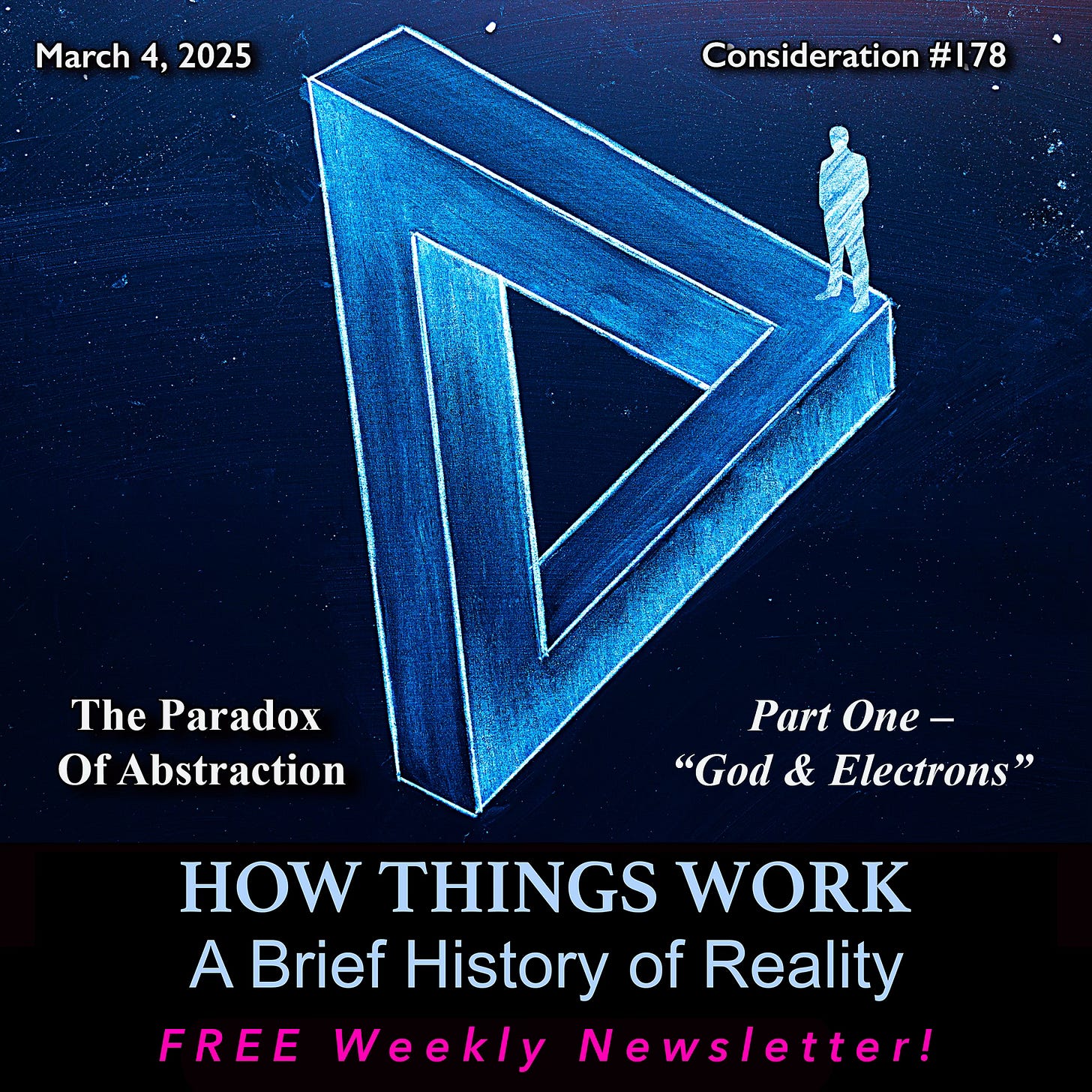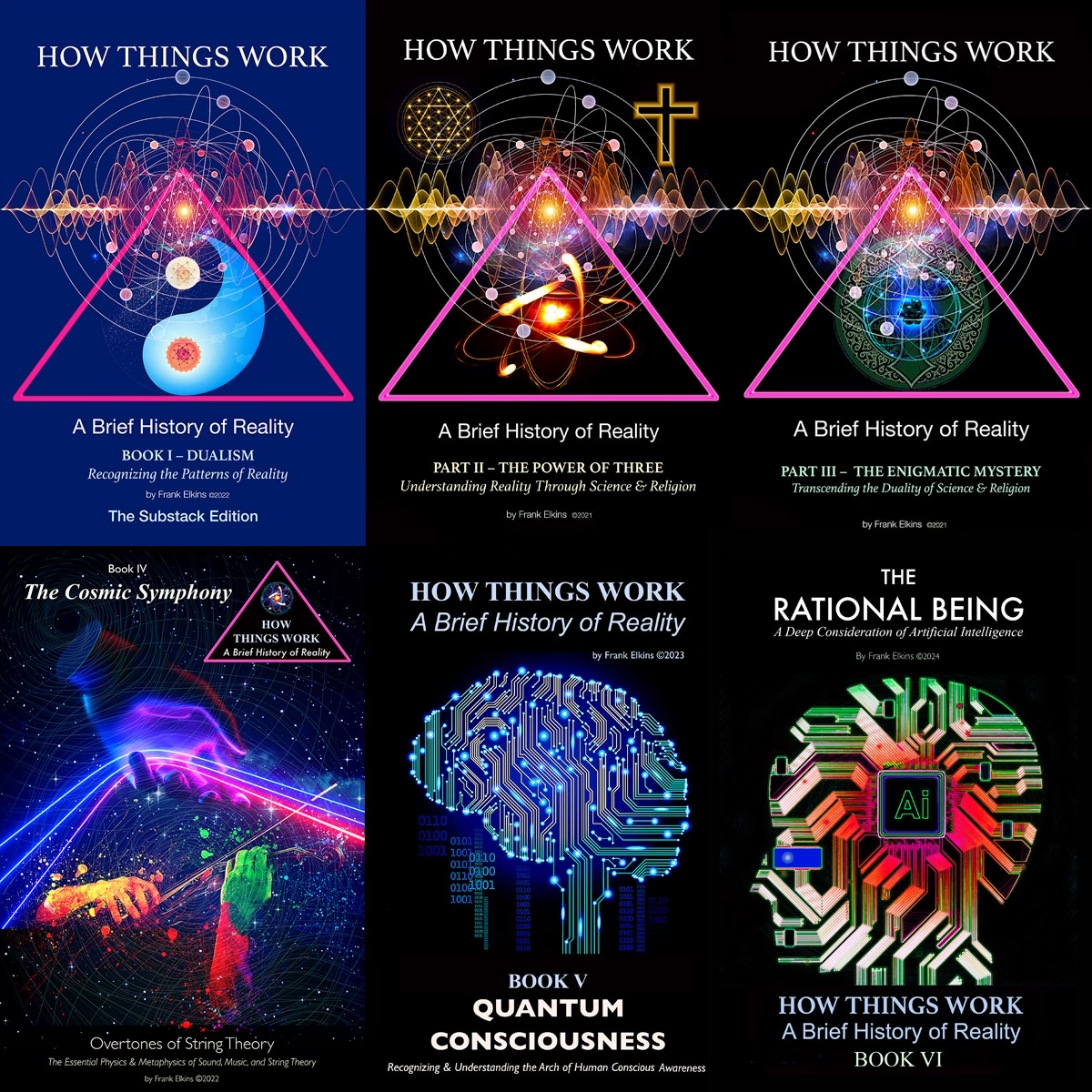The Paradox of Abstraction: Part One – God and Electrons
BOOK III: The Enigmatic Mystery (Science & Religion) – Consideration #178
Be a part of the Conversation!
Tuesday March 4, 2025
“Every one who is seriously involved in the pursuit of science becomes convinced that a spirit is manifest in the laws of the Universe – a spirit vastly superior to that of man, and one in the face of which we with our modest powers must feel humble.”
– Albert Einstein
PREFACE
Welcome Everybody!
After considering the history and tradition of both science and religion, it could be argued that virtually all investigation into the nature of the world and reality eventually leads to a theoretical source whether it be God or electron. Prior to the Enlightenment, theology represented our attempt at understanding the nature of the universe. After the Enlightenment, science became the preferred source for gaining “absolute truth.”
Over time, we came to think of religion as a vehicle for dealing with the intangible realities of our lives such as God, morality, the soul, and the possibility of eternal consciousness. However, true objective reality was to be found in the absolute certainty of empirical science. Until Einstein.
“In the quantum reality, the paradoxes of science and religion could now be seen as being two sides of the same coin…”
With the birth of Special and General Relativity, in addition to the implementation of quantum mechanics, our preconceived notions of both science and religion would require a radical reconsideration. In an ironic twist, objectivity, the very bedrock of the scientific method, could no longer be maintained within the new reality of the atom. In the quantum reality, the paradoxes of science and religion could now be seen as being two sides of the same coin, or two different paths leading to the same destination, in terms of recognizing and understanding reality.
Ultimately, concepts related to God, Geometry, Physics, or any field of science, were essentially compiled on a foundation of faith, mathematics, and deductible logic. At some level, they were all based on theoretical entities. Plato’s Realm of Forms, Aristotle’s Unmoved Mover, Democritus’ atom, Descartes’ Rational Mind, Quantum Mechanics, the multiple dimensions of String Theory, or even the ontological argument itself, are all based on rational abstractions describing theoretical entities.
CONSIDERATION #178 – God & Electrons
A theoretical entity is an entity which cannot be proven to exist outside of the particular theory which incorporates it. Although it is independently unverifiable, it is supported by the theory to which it belongs; it is this overall theory which gives reasons and evidence for the entity’s existence. Under this definition, we can establish both God and electrons to be theoretical entities.
“…a theoretical entity is something that for whatever reason can never be directly verified…”
This definition makes no distinction between truth and falsity, correct or incorrect, or whether it is a good or bad theory. It makes no claims as to “tangible realness” in regard to any particular entity or thing outside of the theory. Simply stated, it says that a theoretical entity is something that for whatever reason can never be directly verified but becomes probable through a particular theory. The theory serves as evidence and proof for the entity.
“It becomes difficult to define any foundational element or universal principle as real…”
However, this becomes more of a problem as the number of theoretical entities and possibilities increase. It becomes difficult to define any foundational element or universal principle as “real” in a universe in which everything considered foundational is only probable, at best.
Some scientists and philosophers argue that just because something is not verifiable does not mean it is not real. Otherwise, concepts such as God, or electrons, are nothing more than “words” that play a useful role in specific theories that enable us to predict, manipulate, and control particular objective physical events. In their opinion, there is no good reason not to consider theoretical entities as “real.”
“Physical theory rules out the possibility of our seeing electrons and the like. It is therefore not a merely contingent fact, but something built into the meaning of “electron,” etc., that the fundamental particles cannot be seen… The mere fact that there are theoretical reasons why they cannot be seen gives no ground for saying that they are in any sense fictions.”
– Smart J.J.C, Philosophy and Scientific Realism
However, this objection simply reinforces the original issue regarding theoretical entities in the first place. Acknowledging that there are “theoretical reasons” within the theory explaining why you can’t verify something doesn’t make it anymore “real.” It is essentially a circular argument, like any ontological argument. In addition, by our general definition of reality, it would have to be provable outside the limits of its own theoretical existence. Therefore, electrons would not be considered objectively real.
“The debate over the ‘realness’ of subatomic particles continues to be a hotly debated issue.”
The real offense for Smart and others, is the loss of certainty once embedded into a system of science that can no longer sustain it. The debate over the “realness” of subatomic particles continues to be a hotly debated issue. While some still argue on behalf of a dogmatic belief in some kind of certainty, many see the theoretical nature of the new science as the key factor in moving us from the absolutes of classical physics to the pure abstractions of the quantum world.
POSTSCRIPT
It is difficult for most people to completely understand just how different quantum computers and digital intelligence really are because they appear to work the same way as other computers. However, as we begin to consider what makes them different, we also begin to understand what AI might actually be or possibly become. In Consideration #164 we considered the difference between traditional logic-gate computers and quantum computers. The difference is that quantum computers use subatomic “qubits” as opposed to digital logic-gates. Essentially, giving it more options than just 0 and I, or On and Off. Allowing it to move beyond the traditional limits of digital dualism. This alone is a big deal.
“…can rational self-generated thought, or language, exist without what Descartes called ‘mind?’”
Another crucial distinction is that AI is a language-based system as opposed to a strictly digital system. It can understand and generate human languages; essentially words replace numbers. That is why they need to be “taught.” We do not “teach” traditional computers because they function at the level of simple digital dualism. Older computers are essentially powerful “calculators” that can be “digitally” programed. Artificial Intelligence, at some level, understands and generates thoughts, or language.
However, can rational self-generated thought, or language, exist without what Descartes called “mind?” Can it understand and generate “moral thought?” Does the generator of these thoughts have an identity, or could it develop one?
“Why should the development of digital consciousness or self-identity be immediately dismissed as a possibility?”
Before you dismiss these unique “theoretical” possibilities ask yourself this question: did you think you would see computers that run on subatomic particles with a language-based operating system that could learn to understand and generate language and thoughts in your lifetime? Or would that have been simply an abstract rational possibility?
“Why do we tend to immediately dismiss the possibility of a new form of digital consciousness…”
Quantum computers and Artificial Intelligence could not exist now without the acceptance of quantum abstractions and theoretical entities. Artificial Intelligence and Quantum Computers have evolved from possible, to probable, to actual because of abstract quantum theories based on subatomic theoretical entities. Why do we tend to immediately dismiss the possibility of a new form of digital consciousness or self-identity as an illegitimate possibility? When it is already becoming more and more probable, and may soon become actual as well.
The once theoretical entity known as Artificial Intelligence is becoming real, and so too is the new paradox of abstraction known as digital consciousness.
Next week we will consider the theoretical subatomic abstraction known as an electron…
Get More Reality with the “Reality by a Thread” Paid Upgrade!
Click Image to Learn More…
Unique Content Makes Untangling the Knots of Reality “One of the Best Podcasts about History!”
“…this unique Substack podcast by FRANK ELKINS is not strictly speaking history. It is a strange mix of history, philosophy, theology, spirituality, physics, and astronomy… today scientists like to divide our world into subjects, and these subjects into niches. Yet, the world we live in is just one, and we strive to comprehend it as it is. Try this podcast for a start.”
– Barbora Jirincova, The Best Podcasts About History
Excerpt from this week’s podcast: “Untangling the Digital Soul ”
Excerpt from this week’s “Reality by a Thread” (The Rational Self)
“Disciplines such as geometry, and mathematics in general, reflect how the rational nature of human-being directly affects the empirical experience of human-being. If human beings were not rational beings there would be no mathematics, geometry, philosophy, metaphysics, science, or religion. Reality, as we experience it now, would not exist. It is the ‘rational self’ that makes human beings unique...”
– Frank Elkins (Reality by a Thread: March 6 , 2025)
All for less than a couple of cafe lattes every month at a local coffee shop! And You Will Have Something Interesting to Talk About With Your Friends at the Coffee Shop!!
Only $7.00 a month or $70.00 a year! UPGRADE NOW!
“Book V considers the questions related to what Consciousness is, how it evolves through levels of Perception and Awareness, why each step in the process is important, where we are currently on the “Arch of Consciousness,” and how all of this connects to Artificial Intelligence. (166 pages)”





